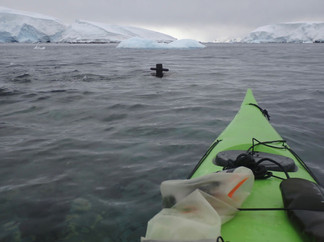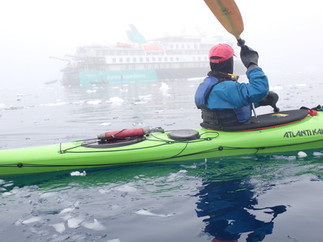Kayak Antarctica: A Self-Guided Safari Through Ice and Wildlife
- Ruth Bergman

- Mar 19
- 13 min read
Updated: Mar 25
Self-Guided by Circumstance: The Kayak Expedition That Took a Turn
When we planned our kayak trip to Antarctica, the trip was a collaboration between Icebird Expeditions and Jeff Allen, a renowned kayak adventurer and instructor for kayak guides. It was written up on Jeff Allen's site at the time as an expedition for advanced kayakers only with a spirit for adventure.
As the departure date approached and we still hadn’t received any paddling-specific information, we reached out to Jeff directly. That’s when we learned that he was unable to join the expedition due to personal reasons. About a week later, Icebird Expeditions informed us that another kayak guide would be joining. We were doubly relieved—first, to have a guide at all, and second, because it was Piotr, whom we had kayaked with in Iceland.
Unfortunately, a series of delays in Ushuaia (see my Antarctica itinerary post) and poor communication from Icebird Expeditions led to Piotr’s decision to leave the expedition. At that point, we had to do some serious soul-searching. The owner and captain of Icebird assured us that we could still have a kayak-focused expedition and that the crew would support us. The captain was an experienced seafarer, well-versed in assessing sea conditions—wind, waves, and currents. However, we would have to paddle without a dedicated kayak guide.
Ultimately, what drove my decision to continue was the belief that, even without a guide, we would see and do more kayaking than on any alternative Antarctic expedition. In hindsight, that assessment proved to be accurate.
Once in Antarctica, after a couple of paddle days, it became clear that we had two distinct groups of kayakers, divided by both skill level and interest. That’s when our group, the more experienced paddlers, became self-guided. Each day, we held a briefing with the ship’s captain, reviewing maps, directions, and conditions. We carried a VHF radio, an emergency locator beacon, a couple of flares, and, after a few days, an iSailor app loaded with Antarctic charts. And with that, we were off.
Looking back, I have no regrets about our decision to continue. Our kayak experiences in Antarctica were nothing short of magical—otherworldly, breathtaking, and beyond compare to anywhere else I’ve paddled. I presume the original trip, with Jeff Allen, would have been a different adventure. As it was, the absence of a guide didn’t diminish the adventure; if anything, it made our connection with the raw, untamed beauty of Antarctica even more profound.
Ice, Ice, Maybe: Finding a Path Through the Frozen Maze
On our very first paddle in the Melchior Islands—our so-called warm-up paddle—we set off in perfect conditions. The excitement was palpable as we glided onto the water beneath blue skies, surrounded by glaciers, with a few icebergs drifting nearby and seals both in the water and on land. It was an idyllic setting for a paddler.
As we turned into a narrow channel, we saw more ice—smallish icebergs, broken pieces that had calved from larger ones as they melted and fractured. By the time we reached the entrance, the channel was completely blocked. It was low tide. We checked either side, searching for a way through, but there was none. Instead, we had to find an alternate route, which we did, paddling down another equally beautiful channel.
The next day, on our paddle through Lemaire Channel, it wasn’t long before we found ourselves in a field of ice. This time, the pieces were much smaller, allowing us to push them aside and chart a path with our kayaks. At first, it took some effort to gain confidence in paddling through the ice like this. Every time ice struck the kayak—or we struck the ice—it sounded bad. I kept wondering whether a kayak could truly withstand such sustained contact. I glanced at our Danish friend Erik for reassurance. He had surely paddled in conditions like these before, and his steady presence gave me confidence.
On our tenth and final day of paddling, at Yankee Harbor, we once again encountered a heavy ice field. It was windy, so we chose to paddle near the shore, where eddies of calmer water formed. But that’s also where the wind and waves were pushing the ice. Given the choice between battling the wind or navigating the ice, we chose ice.
By then, we were well-practiced in finding a path through. We learned to follow each other, using the path cleared by the paddler ahead. We took turns leading—much like cyclists drafting in a pace line—to share the effort of breaking through. It became almost a game, trying to minimize my own effort and gauge just how little ice I could move while still forging a way forward.
Danger in the Silence: Paddling Between Icebergs and Glaciers
When a glacier calves, it can unleash a wave as high as four meters (12 feet). Needless to say, you don’t want to be anywhere near that in a kayak. The same goes for icebergs—massive, unpredictable, and capable of shifting, breaking, or even rolling over without warning, sending waves rippling outward. As we set off down Lemaire Channel, we received a stern warning: stay away from unstable glacier faces and drifting icebergs.
Lemaire Channel is the kind of place that defines Antarctica’s otherworldly beauty. Towering glaciers flank both sides, displaying millennia of accumulated ice. Cracks snake through their surfaces, marking the slow, inevitable movement of the frozen giants. Ice caves glow with the deep, almost supernatural blue of compressed ice. Rock faces are rare, and the middle of the channel is a chaotic highway of ice calved from the glaciers. The soundtrack to this landscape is a mix of deep, echoing rumbles and the occasional thunderous crash of falling ice.
More than once, we found ourselves in an uneasy predicament—an unstable glacier face on the right, another on the left, and a giant iceberg ahead, its own fractured walls threatening collapse. It was impossible to keep a safe distance from all three hazards. So we did the only thing we could: we picked the least objectionable route and paddled fast, hoping to clear the danger zone before anything shifted.
Other days, we paddled among towering icebergs in the calmest waters imaginable. The gray sky deepened the contrast, making the ice glow an even more striking blue as its reflection shimmered on the glassy surface. Silence stretched for hours, broken only by the occasional breath of a whale or the chatter of passing penguins. A deep, meditative serenity settled in.
And then, you get complacent.
You forget that these gentle giants hold immense power, that their stillness is deceptive. On our paddle from Pléneau Island to Booth Island, we found ourselves navigating a maze of densely packed icebergs. We wove between them, marveling at their shapes, textures, and the countless shades of blue trapped within the ice. Since I had the best grasp of our route, I took the lead, carefully choosing paths between the towering ice. I did my best to avoid unstable faces and teetering bergs, but it didn’t always work.
At one point, the way ahead was a labyrinth of ice, the bergs so close together that choosing a safe route became a guessing game. I picked what seemed like the safest option and paddled through. It was the wrong choice.
As I passed between two icebergs, I noticed the stunning, vibrant blue of ice beneath the surface—so close it seemed within reach. Then, with a sinking realization, I saw that same blue completely surrounding me. That could only mean one thing: I wasn’t between two icebergs. I was in the middle of one.
There’s no picture of that moment. No time for a camera. Just the pulse of adrenaline, the rapid strokes of my paddle, and the sheer urgency to escape.
When the Wind Decides: The Power and Peril of an Antarctic Downwind Run
In Antarctica, everything depends on the weather—and the weather can change in an instant. For much of our kayaking, we had the protection of islands, but whenever we were exposed to the open sea, we felt the full force of the wind and swell. As we made our way north toward the South Shetland Islands, conditions became increasingly unpredictable.
One morning, we launched from the Icebird, which was docked alongside the wreck of the Governoren, for a paddle around the island and down the channel. Before we set off, the captain gave us a familiar but always ominous briefing.
“It should be good around this island. The wind should be with you on the way back,” he said, then shrugged. “But winds are changing, so who knows? It depends on the weather.”
He wasn’t wrong.
As we circled the island, the water lacked that perfect, mirror-like stillness that makes for dreamlike paddling, but it seemed manageable. I thought to myself, This is fine. I’m glad we decided to go out. To our left, a glacier loomed over the water; to our right, remnants of Antarctica’s whaling past—a few ancient wooden dinghies abandoned on the shore.
We turned a corner, and a side wind picked up. Another turn, and now we had a light tailwind. Oren was nervous, but these conditions were well within our skill level. Then, as we rounded another bend, the water stilled. We took a break on what had to be the tiniest island imaginable, home to a single, solitary penguin. Three rusting metal crosses jutted from the ground—likely relics from an old mooring site.
We continued down the channel, gliding past the vast Antarctic mainland. The water remained surprisingly calm, and we set a turnaround time to ensure we’d be back aboard the Icebird for a late lunch.
But then the wind shifted.
At first, it was just a steady headwind. By the time we turned around, it had strengthened. No problem, I thought. At least the wind will push us back faster.
I was wrong.
Minutes into our return, the wind intensified. The swell built to half a meter, whitecaps forming around us—a telltale sign of wind speeds around 15 knots (27 km/h). The conditions were still within our capabilities, but here, in Antarctica, with water temperatures below freezing and the Icebird still far away, we had no desire to test our rescue skills. Nor did we feel fully confident in them under these conditions. Oren was panicking. For the first time, I found myself wishing we had an expert kayak guide.
The wind and waves pushed us into the channel, where conditions worsened. Our rudders, which were never tuned properly, were useless against the powerful swell. As I tried to change direction, my kayak turned sideways to the waves—exactly where I didn’t want to be. The waves slammed into my side. Thank goodness for all that shore-break practice back home. I was using every bit of skill I had to stay upright.
We fought to stay together, but control was difficult. Spotting a pair of icebergs closer to shore, we made a beeline for them, hoping for some shelter. The moment we reached the calmer waters beneath their towering forms, the relief was palpable. We rafted together, catching our breath. I glanced around and chuckled—one of the metal crosses from the old mooring site was barely visible above the water. A strangely fitting marker for our survival.
From there, it was another hour back to the Icebird. No further drama—just the usual Antarctic backdrop of icebergs, glaciers, penguins, and seals accompanying us on the way.
Strangers on the Ice: Human Moments in an Icy World
It is always a comfort, in the vast remoteness of Antarctica, to encounter people—or even just a beacon of humanity, like a ship or a research base. A base might serve as a marker, reassuring us that we are heading in the right direction. If we felt a moment of disorientation after leaving Icebird from its bay within a bay in Paradise Bay, that uncertainty vanished as soon as we spotted Base Brown, proudly flying the Argentine flag and guarded by hundreds of penguins.
The Ukrainian base, Vernadsky, with its many antennas, became a landmark as we navigated a channel crossing. After several hours of paddling, pure joy washed over us at the sight of its buildings—and a few people milling about onshore. On our paddle to Pleaneau Island, a ship with two masts served as our destination. Without that marker, we never would have found the hidden bay that would be our home for the night. At times, it felt like we were paddling in circles, chasing those two masts through the icy expanse.
We quickly learned that while we could see ships from a great distance, they could not see us. Still, it was reassuring to know we weren’t entirely alone. We watched as expedition vessels went through the lengthy process of unloading passengers onto zodiacs, appreciating the freedom our kayaks gave us to explore on our own terms.
A few times, we crossed paths with a zodiac. The reaction was always the same—surprise at the sight of three lone kayaks in such an extreme setting. The encounters were brief but friendly, with a wave or a quick exchange of words if they came close enough. Inevitably, they would ask the same curious question: What boat did you come from? And where is it now?
Kayak, Meet Penguin: The Adorable and Unfazed Wildlife of Antarctica
The indigenous population of Antarctica is, of course, penguins. Before coming here, I had never seen a penguin in the wild, so my delight was understandable when I spotted my first one—then my first colony, then my second. At first, I probably took a picture of every single penguin I saw. But after encountering what must have been 50,000 of them, spanning all three species common to this region—Gentoo, Adélie, and Chinstrap—I came to realize just how omnipresent they are in this remote and icy world.
From the vantage point of a kayak, I could watch penguins enter the water at eye level. On land, they are slow and lumbering, but in the water, they transform—suddenly sleek, fast, and powerful. Groups of ten or more would launch themselves across our path, their small bodies bouncing effortlessly through the waves, leaving us to marvel at their speed and agility.
Observing penguin colonies on land gave us insight into their social behavior, but we also witnessed it from the water. When the wind picked up, entire groups would turn to face it together, their small wings stretched out, or they would huddle in a circle for warmth. They entered the water in coordinated groups, swam in formation, and leapt back onto the shore in an impressively orderly line.
From our kayaks, we saw massive penguin colonies stretching far up into the hills. Penguins build their nests anywhere exposed rock exists along the Antarctic shoreline, and despite their awkward waddling gait, they are surprisingly adept at climbing steep slopes. Coming down is another story—some take slow, careful steps, while others opt for the more efficient method of sliding belly-first down the icy paths. Over the course of the Antarctic summer, they wear down well-trodden "penguin highways" leading to their high-altitude rookeries.
What surprised me most was how utterly unafraid penguins—and most Antarctic animals—are around humans. We were repeatedly warned not to kiss the penguins, and honestly, you could. You could walk right up to them, and they wouldn’t flee. On land, where they have no natural predators, they regard humans with curiosity rather than fear. In the water, though, it’s a different story—you’ll never catch a penguin there.
Seals on Ice: The Lazy Kings of Antarctica’s Frozen World
I love seeing seals in the wild. These curious and playful creatures have frequently entertained us as we paddled along. The Antarctic Peninsula is home to an abundance of seals, with six species commonly spotted during the summer months—Weddell seals, Crabeater seals, Leopard seals, Antarctic fur seals, and Southern elephant seals. We were lucky enough to see all of them, whether from the boat, on land, or up close from our kayaks.
Most of the seals we encountered were lazily sprawled across icebergs, completely unbothered by our presence. Many barely moved, though a few condescended to raise their heads, casting us a brief look before resuming their nap.
After a few days, I became quite skilled at spotting seals from a distance, easily distinguishing them from rocks or dirty ice. We usually saw several in a day's paddle and would choose one or two to observe more closely, hoping to catch an active one. Occasionally, a seal would lift its head or even sit up, and once, we saw one leap onto an iceberg near the boat—something I would have loved to witness from the kayak.
We also held onto a half-serious hope of witnessing an orca hunt near us. That never happened, which was probably for the best. However, we did stumble upon an incredible National Geographic-worthy encounter between fin whales and orcas while on the boat—an unforgettable moment.
Seals are everywhere in Antarctica, and if you spend any time paddling its icy waters, you’re bound to see them. Whether lounging on icebergs or gliding through the water, they are a constant and enchanting presence in this frozen world.
A Whale’s World: Drifting Beside the Giants of the Southern Ocean
One of the great pleasures of kayaking is the chance to be close to nature—especially to sea mammals—and the bigger, the better. Encountering a whale is the ultimate hope of any kayak trip. Midway through our expedition, our captain jokingly told us we had bad whale karma. We hadn’t noticed; we had already seen more whales than on any other trip. But not many while paddling—until we reached Paradise Bay.
We spent two days kayaking in Paradise Bay and had unexpected close encounters with whales on both. On the first day, we paddled to Leith Cove, famous for its glaciers. For about an hour, we saw plenty of penguins but no whales. Then, we started hearing whale breaths—loud, rhythmic exhalations echoing across the bay. We scanned the water and finally spotted a whale at the far end of the bay. As we stopped to watch, we quickly realized there were two of them. They were moving slowly—directly toward us.
These whales didn’t behave like others I had seen elsewhere. They weren’t surfacing and diving in a predictable rhythm. Instead, they moved very little, as if resting. We easily kept pace with them as we followed, mesmerized.
Reluctantly, we turned away and continued paddling deeper into the bay, where we spotted another pair of whales on the far side. Once again, they were getting closer. Then, amidst the usual soundtrack of rumbling glaciers and echoing spouts, a new sound cut through the air—something unfamiliar, almost otherworldly. It took me a moment to realize: I had just heard a whale vocalization.
The next day, our encounters continued. While paddling, we spotted a whale hardly moving, drifting with the current and letting out small blows. Following the trail of mist, we caught up to it, floating quietly alongside as the current carried us both. It paid no attention to us. That’s when we got stupid.
We were so close that I suggested to Oren that I take a picture of him with the whale. He paddled alongside it, peering into the water and seeing its full, massive form beneath the surface. What you see above water is just a fraction of the whale’s true size. The picture didn’t turn out, and suddenly, I found myself directly behind the whale as it contracted, preparing to move. I held my breath, hoping it wouldn’t use its tail to dive at that exact moment. Thankfully, it didn’t. But that was the moment I truly grasped the enormity of these creatures—and the thin line between awe and recklessness.
The Ice Stays With You: Lessons from a Self-Guided Antarctic Journey
Kayaking without a guide in Antarctica was, for the most part, an incredible gift—one that gave me a deeper connection to the landscape, a stronger sense of personal ownership over the journey, and a newfound confidence in my skills as a paddler. For 95% of the trip, it was exactly what I wanted. But for that other 5%—when the winds picked up, the swells grew unpredictable, or we found ourselves in conditions at the edge of our comfort zone—a guide would have been a welcome reassurance.
Antarctica is the ultimate sea safari, unlike anywhere else in the world. Every paddle brought encounters with icebergs, whales, seals, and penguins, set against the backdrop of an untouched, frozen wilderness. It was humbling to navigate these waters, where nature is still in control. In the end, this journey wasn’t just about kayaking—it was about experiencing one of the last truly wild places on Earth, on its own terms.












































































Comments